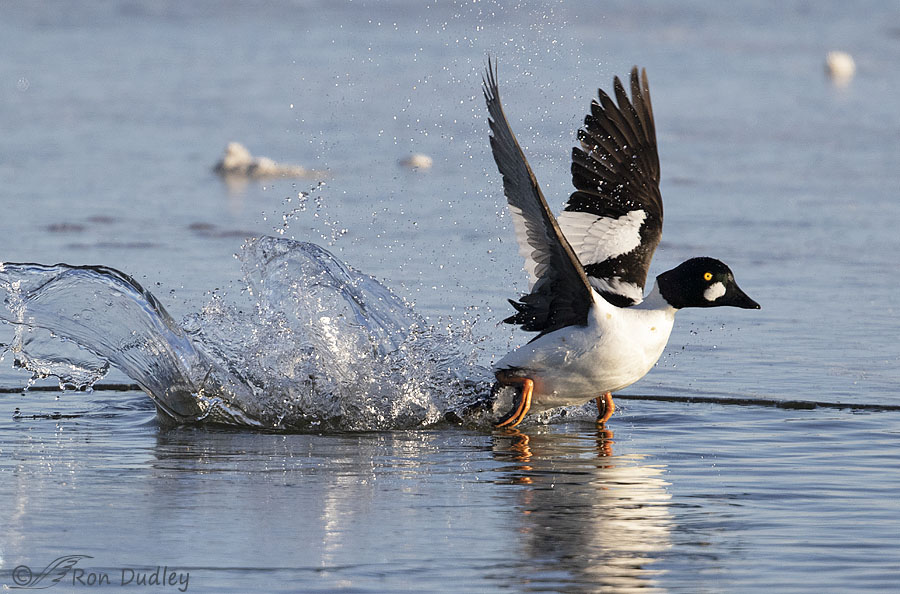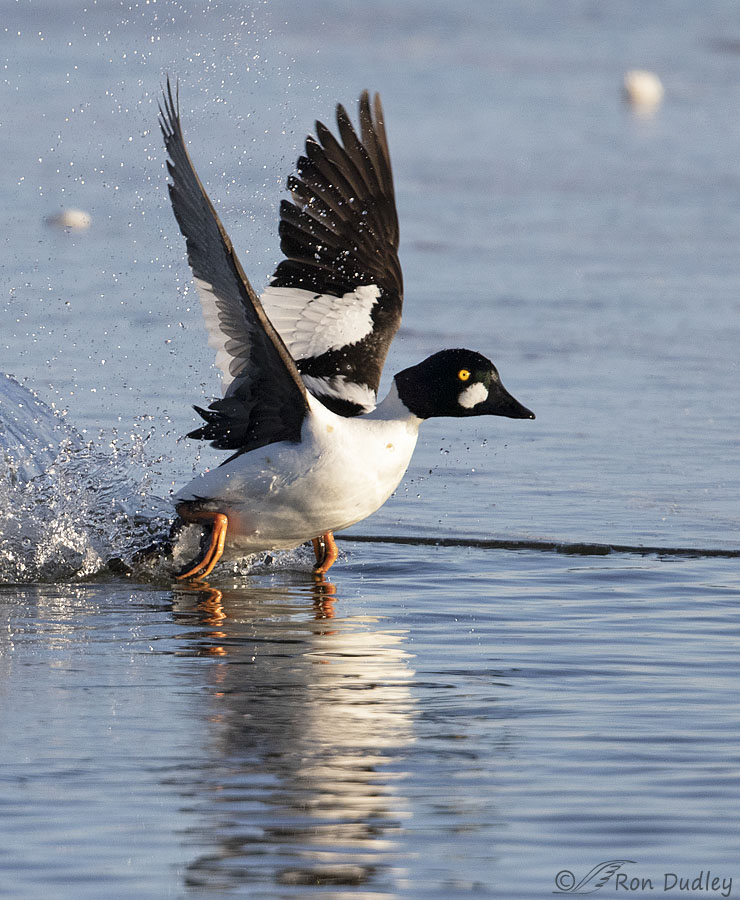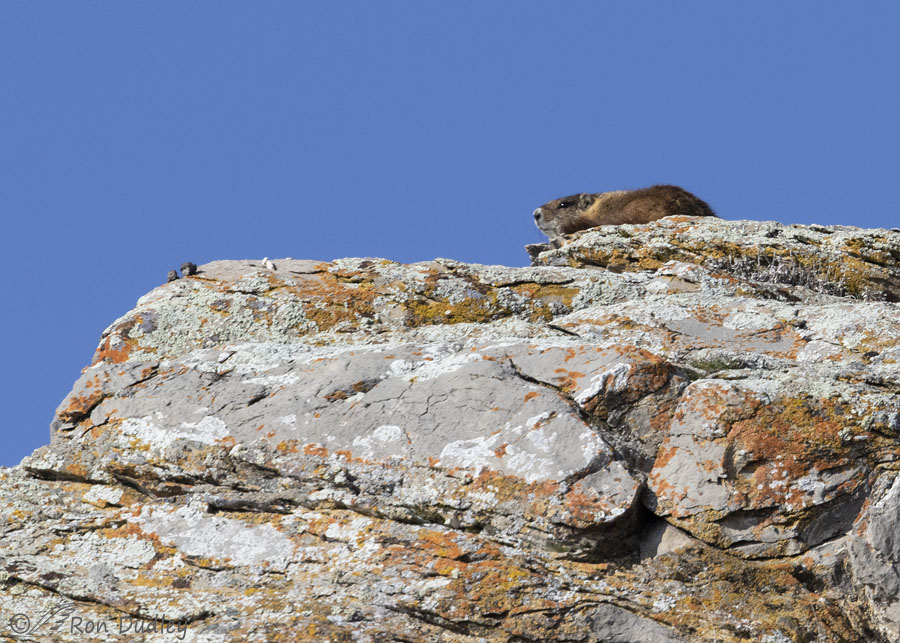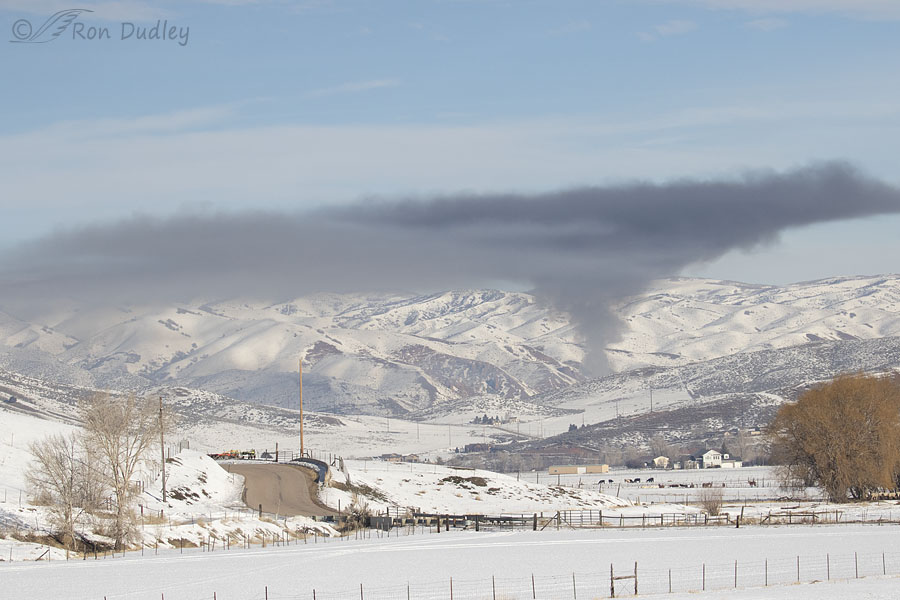Plus a critter who woke up too early. Way too early.

1/5000, f/6.3, ISO 800, Canon 7D Mark II, Canon EF 500mm f/4L IS II USM + EF 1.4 III Extender, not baited, set up or called in
This time of year on the west side of the Bear River MBR auto tour loop there’s often only a narrow strip of open water between the road and the rest of the ice-covered impoundment. So waterfowl confined to the open water close to the road often feel threatened by approaching vehicles and take off before you can get good morning light on them. They feel even more threatened when you stop your vehicle so you typically have to be very quick on the trigger to have a chance of photographing them before they’re gone.
That’s what happened here. The dark line directly behind the goldeneye is the ice/water boundary. Because of the ice the duck couldn’t swim away from me so he chose to take off to the south and this old man’s reflexes were quick enough to get him in focus and keep him in frame for this photo taken at the beginning of his explosive takeoff.
In situations like this I like water splashes in my photos so I’ve cropped the image unconventionally to include most of it. The bird is strongly side lit but I think the photo still works and works pretty well.

A vertical composition of the same photo makes the bird larger in the frame at the expense of losing most of the water splash. A strongly side lit black and white bird is a tough exposure so I was pleased and just a little surprised by how well the image turned out.
I photographed the goldeneye on January 9, eight days ago. Six days after that, on January 15, I was stunned when I was able to document a mammal outside its burrow that should be hibernating for another couple of months.

The Yellow-bellied Marmot was sunning itself atop a rock outcrop high above me on a morning that had been 10° F. not long before I took the photo. I’m sure it was still about 15° below freezing when I got this marmot in my viewfinder.
Marmots are true hibernators and this one should have still been in its burrow, oblivious to the world. Around here I usually don’t see the first marmots until sometime in March. This from the National Park Service about Yellow-bellied Marmots:
“Marmots spend over half their lives in hibernation. They enter their burrows in September to early October and don’t emerge again until the following April or May.”
These days most everything seems to be wonky, including our politics, our health and poor old Mother Nature. Like most everyone else I yearn for ‘normalcy’, whatever that is.
Ron
Late Addendum:

Do any locals know what was going on here?
Mid-morning yesterday there was what appeared to be a large fire in the Wasatch Mountains near Croydon and southwest of Lost Creek Reservoir. To give you an idea of distance and scale this photo was taken from miles away from the fire’s source. I haven’t seen any news reports about it and I’m quite curious.
PS – Soon after I posted this photo I got an answer to my question from friend and fellow photographer Judy Watson. Thanks, Judy.


Stunning and beautiful Ron!
Thanks forr sharing!
Charlotte Norton
The horizontal format tells a story, so I like it. Seeing the word “woke” suddenly distracts me nowadays. Also saw the effects of the bark beetles in New Mexico just before I moved away in 2004. The Pinyon-Juniper woodlands lost almost 90% of their pines and the large flocks of Pinyon Jays disappeared, at least at the 7000 foot level where we lived. Pollution and warming climate were blamed. The beetles chewed so loudly you could hear them from 5 feet away.
Normally, I’m “Team Vertical,” but the first crop absolutely blows me away. What a treat!
A “shop” would definitely put up plenty of back smoke – sad for the loss but at least other buildings were spared…..
Judy, it doesn’t look like it in the photos but apparently it was a new shop for his intended business. It had a lot of very expensive equipment in it and it was all destroyed by the fire. He was in the process of getting insurance on it but he didn’t have it yet.
I’d love to know the physics causing those water wings in the first photo, as well as the smoke formation from the fire.
Unfortunate that we have to consider climate change as a variable when seeing a marmot in January. At least we’re making the planet more hospitable for mosquitoes and mountain pine beetles.
“At least we’re making the planet more hospitable for mosquitoes and mountain pine beetles”
I’m afraid you’re right, Lyle.
Several years ago, maybe 7 years, our groundhogs started emerging early in southern Wisconsin. They were moving around a bit to find grass that was still green.
Pam, I assume that means they’re still coming out early. Not a good thing in my opinion.
Ron – your Bird/Water studies of the last few posts are magnificent. This one is just spectacular! The close crop on the duck is nice for the details (those weird orange feet and the translucency of the feathers on the right wing), but what a story you tell with the unconventional crop! To these eyes, the photo more than “works pretty well”.
I’m glad you enjoyed the first version, Carolyn – and for the same reason I enjoy it.
I like both views of the Goldeneye, but am partial to the landscape view which shows more of the splashing water.
Can’t comment on why the marmot is out and about since I’ve never even seen one. As a specialist in hibernation (my own), I do wonder why one would emerge from a nice warm den in winter for any reason.
Wally, you’ve always had a way with words and the last sentence in your comment is further evidence of that fact. Made me smile.
How I love the Goldeneye getting the hell out of Dodge. And much prefer your unconventional crop, with its bigger picture.
I feel for the marmot. It was shortly before two when I first got up this morning. I determinedly went back to bed, and it is now just after four.
I am very glad that the fire was contained. Fires scare me (more) witless.
I prefer the unconventional crop too, EC. It tells more of the story.
Check your air pollution control district office about the fire.
Gary, I just posted a link to an explanation about the fire.
Ron. Great shot on the Goldeneye getting off the water in a hurry. There a quick explosive bird on takeoff. As far as the marmot emerging from there den I remember observing marmots in late January sunning themselves above Shoshone Falls on the Snake River sitting on a snow bank. We have marmots at my place of work and I observe male marmots emerging around Valentines Day when they are starting to seek females for the upcoming breeding season. They breed in the den and pups emerge in early to mid April. With the unseasonably hot weather we had in June of last year with nothing to forage on the marmots went in to the den in July. Some of the marmots will die in the den if they didn’t store enough fat for hibernation and will abort the pups from lack of energy stores for gestation. They went to ground 4 to 6 weeks earlier than in a normal year. They could use an early spring cor recovery.
Interesting, Steven. Last year I believe I remember seeing one out in February but it’s typically March before I see my first one.
I found that marmot pup at work and read different scientific research studies to enhance my understanding of the species. The Vancouver Island Marmot is one of the rarest animals in the world and was on the brink of extinction before a captive breeding program was established. Ron do U have any dipper bird photos. There my favorite native species.
I have very few dipper photos but there’s a mediocre one here:
https://www.featheredphotography.com/blog/2014/06/08/my-four-and-a-half-lifers-in-eight-days/
Great job of holding the whites on the bird!
If your area has had a string of days in the high 50s and even low 60s we’ve experienced in Denver, it may be like an alarm clock ringing. The hunger theory also seems possible to have merit.
“Great job of holding the whites on the bird!”
Thanks, Nancy. It takes a photographer to fully appreciate that.
Love it. Great photos. Remarkable how fast ducks can move over water like this. I was walking along one of our lakes a few days ago and suddenly all couple hundred of the various ducks took off together. I knew it wasn’t due to me so looked around and sure enough it was caused by a pair of eagles soaring low over the lake.
Very strange behavior by the marmot that should be waiting for April to be out, but he’s out even before February on a very cold morning. But as you say, these are strange times for all of us and maybe nature as well. The question is – will we ever see normalcy again?
“The question is – will we ever see normalcy again?”
Sadly, I strongly doubt it Everett. Makes me sick to think about it.
Beautiful take off shot! The splashing water in the horizontal crop REALLY adds to the photo IMO. Doesn’t sound good with the Marmot coming out so early with limited grub available. Know the prairie dogs here go down early but come out again fairly early also.
Doesn’t sound good with the Marmot coming out so early with limited grub available. Know the prairie dogs here go down early but come out again fairly early also.
Thanks, Judy. These marmots are omnivores so they’re not strictly limited to green vegetation but this time of year they wouldn’t find much to eat topside of any kind.
Great Goldeneye shot!
Do you know if marmots don’t have enough fat to keep them through hibernation whether that is reason enough to wake up early?
Dick, I don’t know for sure but that seems like a possibility,
Its the males typically that stir early. They are just streching there legs. They will go back into torpor to catch some more zzz and stir every 2 or 3 weeks. In full torpor there heart rate will drop to 6 to 8 beats a minute and body temp down to °35 to °45.